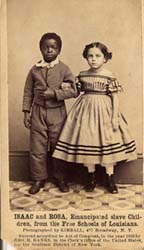

|
This image, as well as the others in the series of photographs of emancipated slaves who toured the North during the Civil War, raise questions about the use of photography as a means of persuasion. These images are a very early example of photography employed as propaganda. As prints from glass plate negatives, they could be reproduced and distributed widely. But what role did the subjects of these portraits play in this process? Did they choose freely to engage in it, or was this a new form of exploitation? What about the use of children? Did they participate willingly in the long studio sessions? Were they paid? Furthermore, the photographs often employ children who look very white, some of whom could certainly pass for white. Several of the captions explicitly refer to this. Were the makers trying to shock the Northern audience and get them to see the arbitrariness of the color line, or was this a further form of exploitation, using the viewers' identification with their own whiteness to sympathize with the subjects of the photographs? For essays that address these and related themes on the Mirror of Race website, see "'As White as their Masters': Visualizing the Color Line", by Carol Goodman and "A White Slave Girl: "Mulatto Raised by Charles Sumner'", by Joan Gage. |